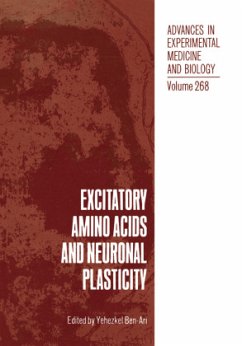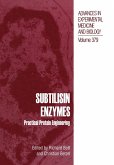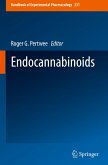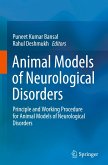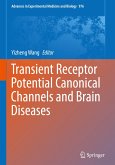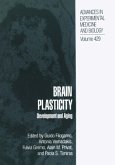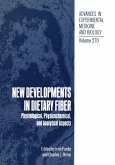Excitatory Amino Acids and Neuronal Plasticity
Herausgegeben:Ben-Ari, Yehezkel
Excitatory Amino Acids and Neuronal Plasticity
Herausgegeben:Ben-Ari, Yehezkel
- Broschiertes Buch
- Merkliste
- Auf die Merkliste
- Bewerten Bewerten
- Teilen
- Produkt teilen
- Produkterinnerung
- Produkterinnerung
Adult and immature nervous system are capable of considerable "plasticity" and unravelling the underlying mechanisms is one of the principal and most fascinating goals of Neurobiology. A major contribution to our understanding of neural plasticity has come from recent studies in excitato ry amino acids - which are thought to mediate a large part of the excitatory synaptic transmission on the brain. Important steps in this explosive field are: 1) the synthesis of relatively specific antagonists of the N-methyl-D aspartate (NMDA) and non-NMDA receptors subtypes, 2) the characterization of the…mehr
Andere Kunden interessierten sich auch für
![Subtilisin Enzymes Subtilisin Enzymes]() Subtilisin Enzymes83,99 €
Subtilisin Enzymes83,99 €![Neuronal Tissue-Nonspecific Alkaline Phosphatase (TNAP) Neuronal Tissue-Nonspecific Alkaline Phosphatase (TNAP)]() Neuronal Tissue-Nonspecific Alkaline Phosphatase (TNAP)147,99 €
Neuronal Tissue-Nonspecific Alkaline Phosphatase (TNAP)147,99 €![Endocannabinoids Endocannabinoids]() Endocannabinoids241,99 €
Endocannabinoids241,99 €![Animal Models of Neurological Disorders Animal Models of Neurological Disorders]() Animal Models of Neurological Disorders110,99 €
Animal Models of Neurological Disorders110,99 €![Transient Receptor Potential Canonical Channels and Brain Diseases Transient Receptor Potential Canonical Channels and Brain Diseases]() Transient Receptor Potential Canonical Channels and Brain Diseases117,99 €
Transient Receptor Potential Canonical Channels and Brain Diseases117,99 €![Brain Plasticity Brain Plasticity]() Brain Plasticity147,99 €
Brain Plasticity147,99 €![New Developments in Dietary Fiber New Developments in Dietary Fiber]() New Developments in Dietary Fiber42,99 €
New Developments in Dietary Fiber42,99 €-
-
-
Adult and immature nervous system are capable of considerable "plasticity" and unravelling the underlying mechanisms is one of the principal and most fascinating goals of Neurobiology. A major contribution to our understanding of neural plasticity has come from recent studies in excitato ry amino acids - which are thought to mediate a large part of the excitatory synaptic transmission on the brain. Important steps in this explosive field are: 1) the synthesis of relatively specific antagonists of the N-methyl-D aspartate (NMDA) and non-NMDA receptors subtypes, 2) the characterization of the unique features of the NMDA receptor channel complex notably its voltage dependent Mg++ blockade, its permeability to calcium and its allosteric modulation by glycine, 3) the demonstration that by virtue of their Ca++ permeability NMDA receptors are involved in many -but not all -synapses in the initiation but not the maintennce of long term potentiation (L TP) an experimented model of learning and memory processes. More recent studies also indicate tha excitatory amino acids also play an important role in developmental plasticity in vivo; in cell cultures low levels of excitatory amino acids have trophic roles and can inhibit or promote neurite growth. Excitatory amino acids also play an important role also in other forms of neural plasticity such as the use dependent permanent changes in neural circuit produced by brief seizures (epileptogenesis) as well as the reactive sprouting and neosynapse formation which take place in epilepsy models and after deafferentiation or lesions.
Hinweis: Dieser Artikel kann nur an eine deutsche Lieferadresse ausgeliefert werden.
Hinweis: Dieser Artikel kann nur an eine deutsche Lieferadresse ausgeliefert werden.
Produktdetails
- Produktdetails
- Advances in Experimental Medicine and Biology 268
- Verlag: Springer / Springer US / Springer, Berlin
- Artikelnr. des Verlages: 978-1-4684-5771-1
- Softcover reprint of the original 1st ed. 1990
- Seitenzahl: 544
- Erscheinungstermin: 30. Juli 2013
- Englisch
- Abmessung: 254mm x 178mm x 30mm
- Gewicht: 1011g
- ISBN-13: 9781468457711
- ISBN-10: 1468457713
- Artikelnr.: 39916261
- Herstellerkennzeichnung Die Herstellerinformationen sind derzeit nicht verfügbar.
- Advances in Experimental Medicine and Biology 268
- Verlag: Springer / Springer US / Springer, Berlin
- Artikelnr. des Verlages: 978-1-4684-5771-1
- Softcover reprint of the original 1st ed. 1990
- Seitenzahl: 544
- Erscheinungstermin: 30. Juli 2013
- Englisch
- Abmessung: 254mm x 178mm x 30mm
- Gewicht: 1011g
- ISBN-13: 9781468457711
- ISBN-10: 1468457713
- Artikelnr.: 39916261
- Herstellerkennzeichnung Die Herstellerinformationen sind derzeit nicht verfügbar.
Mechanisms and Expression of Receptors.- Glutamate Receptors in Cultures of Mouse Hippocampus Studied with Fast Applications of Agonists, Modulators and Drugs.- Measuring and Controlling the Extracellular Glycine Concentration at the NMDA Receptor Level.- The Glycine Coagonist Site of the NMDA Receptor.- The PCP Site of the NMDA Receptor Complex.- Antagonists of NMDA-Activated Current in Cortical Neurons: Competition with Glycine and Blockade of Open Channels.- Types of EAA Receptors.- Experiments with Kainate and Quisqualate Agonists and Antagonists in Relation to the Sub-Classification of 'Non-NMDA' Receptors.- Homocysteic Acid as Transmitter Candidate in the Mammalian Brain and Excitatory Amino Acids in Epilepsy.- Specific Quisqualate Receptor Ligand Blocks Both Kainate and Quisqualate Responses.- Molecular Characterization, Ultrastructural Localization and Gene Cloning of the Chick Cerebellar Kainate Receptor.- Intracellular Messengers Associated with Excitatory Amino Acid (EAA) Receptors.- The Glycine Site on the NMDA Receptor: Pharmacology and Involvement in NMDA Receptor-Mediated Neurodegeneration.- Evidence for Glutamate Receptor Subtypes from in Vivo Electrophysiology: Studies with HA-966, Quinoxalinediones and Philanthotoxin.- Characterization of Membranal and Purified NMDA Receptors.- Ca++ and Excitatory Amino Acids.- Mechanisms Underlying Excitatory Amino Acid-Evoked Calcium Entry in Cultured Neurons from the Embryonic Rat Spinal Cord.- Topographical Heterogeneity of Glutamate Agonist-Induced Calcium Increase in Hippocampus.- Protection by Natural and Semisynthetic Gangliosides from Ca2+-Dependent Neurotoxicity Caused by Excitatory Amino Acid (EAA) Neurotransmitters.- EAA and in Vivo Development.- Periodic Inward Currents Triggered by NMDA in ImmatureCA3 Hippocampal Neurones.- GABA Mediated Synaptic Events in Neonatal Rat CA3 Pyramidal Neurons in Vitro: Modulation by NMDA and Non-NMDA Receptors.- Neural Networks and Synaptic Transmission in Immature Hippocampus.- A Role of NMDA Receptors and Ca2+ Influx in Synaptic Plasticity in the Developing Visual Cortex.- Spontaneous and Evoked NMDA-Receptor Mediated Potentials in the Entorhinal Cortex of the Neonate Rat in Vitro.- Learning by Seeing: N-Methyl-D-Aspartate Receptors and Recognition Memory.- The Role of the NMDA Receptor in the Development of the Frog Visual System.- EAA and in Vitro Development.- Excitatory Amino Acids, Growth Factors, and Calcium: A Teeter-Totter Model for Neural Plasticity and Degeneration.- Trophic Effects of Excitatory Amino Acids in the Developing Nervous System.- Mechanisms of Excitatory Amino Acid-Induced Stimulation of GABAergic Synaptic Activity in Cultures from the Rat Superior Colliculus.- The Role of Taurine and Glutamate during Early Postnatal Cerebellar Development of Normal and Weaver Mutant Mice.- Regulation of Neurite Outgrowth from Cerebellar Granule Cells in Culture: NMDA Receptors and Protein Kinase C.- Regulation of GABAA Currents by Excitatory Amino Acids.- EAA and LTP.- Long-Term Potentiation in the Dentate Gyrus in Vivo is Associated with a Sustained Increase in Extracellular Glutamate.- Long Term Potentiation is not Associated with a Sustained Enhanced Release of Glutamate in the Rat Hippocampus in Vivo and in Vitro.- Postsynaptic Mechanisms Involved in Long-Term Potentiation.- Identifying and Localizing Protein Kinases Necessary for LTP.- Delayed Onset of Potentiation in Neocortical EPSPs during Long-Term Potentiation (LTP) - A Postsynaptic Mechanism or Heterogeneous Synaptic Inputs ?.- Local Circuit ConnectionsMediated by NMDA and Non-NMDA Receptors in Slices of Neocortex.- Modulation of the Responsiveness of Cerebellar Purkinje Cells to Excitatory Amino Acids.- Proteins, Second Messengers and LTP.- The Role of Ependymin in Neuronal Plasticity and LTP.- The Role of Protein Kinase C Substrate B-50 (GAP-43) in Neurotransmitter Release and Long-Term Potentiation.- Different Mechanisms and Multiple Stages of LTP.- Extracellular Proteases and S100 Protein in Long-Term Potentiation in the Dentate Gyrus of the Anaesthetized Rat.- Modulation of the Induction of Long-Term Potentiation in the Hippocampus.- Roles of Metabotropic and Ionotropic Glutamate Receptors in the Long-Term Potentiation of Hippocampal Mossy Fiber Synapses.- Effects of a Neurotrophic Factor (FGF) on Development, Regeneration and Synaptic Plasticity of Central Neurons.- Trans-Synaptophobia.- EAA and Reactive Plasticity.- Kindling, Prenatal Exposure to Ethanol and Postnatal Development Selectively Alter Reponses of Hippocampal Pyramidal Cells to NMDA.- Sprouting of Mossy Fibers in the Hippocampus of Epileptic Human and Rat.- Molecular Markers of Reactive Plasticity.- Transplantation of Developing Hippocampal Neurons to Ischemic and Excitotoxic Lesions of the Adult Rat Hippocampus.- Changes in Synaptic Transmission in the Kindled Hippocampus.- NMDA Receptor Plasticity in the Kindling Model.- NMDA-Receptors are Involved in Synaptic Plasticity Following Partial Denervation of CA1 Hippocampal Cells.- EAA and Anoxia.- Anoxia and NMDA Receptors.- Modulation of ATP Sensitive K+ Channels: A Novel Strategy to Reduce the Deleterious Effects of Anoxia.- Effects of Transient Forebrain Ischemia in Area CA1 of the Gerbil Hippocampus: An in Vitro Study.- Acute Brain Injury, NMDA Receptors, and Hydrogen Ions: Observations in Cortical Cell Cultures.- Mechanisms of Excitatory Amino Acid Neurotoxicity in Rat Brain Slices.
Mechanisms and Expression of Receptors.- Glutamate Receptors in Cultures of Mouse Hippocampus Studied with Fast Applications of Agonists, Modulators and Drugs.- Measuring and Controlling the Extracellular Glycine Concentration at the NMDA Receptor Level.- The Glycine Coagonist Site of the NMDA Receptor.- The PCP Site of the NMDA Receptor Complex.- Antagonists of NMDA-Activated Current in Cortical Neurons: Competition with Glycine and Blockade of Open Channels.- Types of EAA Receptors.- Experiments with Kainate and Quisqualate Agonists and Antagonists in Relation to the Sub-Classification of 'Non-NMDA' Receptors.- Homocysteic Acid as Transmitter Candidate in the Mammalian Brain and Excitatory Amino Acids in Epilepsy.- Specific Quisqualate Receptor Ligand Blocks Both Kainate and Quisqualate Responses.- Molecular Characterization, Ultrastructural Localization and Gene Cloning of the Chick Cerebellar Kainate Receptor.- Intracellular Messengers Associated with Excitatory Amino Acid (EAA) Receptors.- The Glycine Site on the NMDA Receptor: Pharmacology and Involvement in NMDA Receptor-Mediated Neurodegeneration.- Evidence for Glutamate Receptor Subtypes from in Vivo Electrophysiology: Studies with HA-966, Quinoxalinediones and Philanthotoxin.- Characterization of Membranal and Purified NMDA Receptors.- Ca++ and Excitatory Amino Acids.- Mechanisms Underlying Excitatory Amino Acid-Evoked Calcium Entry in Cultured Neurons from the Embryonic Rat Spinal Cord.- Topographical Heterogeneity of Glutamate Agonist-Induced Calcium Increase in Hippocampus.- Protection by Natural and Semisynthetic Gangliosides from Ca2+-Dependent Neurotoxicity Caused by Excitatory Amino Acid (EAA) Neurotransmitters.- EAA and in Vivo Development.- Periodic Inward Currents Triggered by NMDA in ImmatureCA3 Hippocampal Neurones.- GABA Mediated Synaptic Events in Neonatal Rat CA3 Pyramidal Neurons in Vitro: Modulation by NMDA and Non-NMDA Receptors.- Neural Networks and Synaptic Transmission in Immature Hippocampus.- A Role of NMDA Receptors and Ca2+ Influx in Synaptic Plasticity in the Developing Visual Cortex.- Spontaneous and Evoked NMDA-Receptor Mediated Potentials in the Entorhinal Cortex of the Neonate Rat in Vitro.- Learning by Seeing: N-Methyl-D-Aspartate Receptors and Recognition Memory.- The Role of the NMDA Receptor in the Development of the Frog Visual System.- EAA and in Vitro Development.- Excitatory Amino Acids, Growth Factors, and Calcium: A Teeter-Totter Model for Neural Plasticity and Degeneration.- Trophic Effects of Excitatory Amino Acids in the Developing Nervous System.- Mechanisms of Excitatory Amino Acid-Induced Stimulation of GABAergic Synaptic Activity in Cultures from the Rat Superior Colliculus.- The Role of Taurine and Glutamate during Early Postnatal Cerebellar Development of Normal and Weaver Mutant Mice.- Regulation of Neurite Outgrowth from Cerebellar Granule Cells in Culture: NMDA Receptors and Protein Kinase C.- Regulation of GABAA Currents by Excitatory Amino Acids.- EAA and LTP.- Long-Term Potentiation in the Dentate Gyrus in Vivo is Associated with a Sustained Increase in Extracellular Glutamate.- Long Term Potentiation is not Associated with a Sustained Enhanced Release of Glutamate in the Rat Hippocampus in Vivo and in Vitro.- Postsynaptic Mechanisms Involved in Long-Term Potentiation.- Identifying and Localizing Protein Kinases Necessary for LTP.- Delayed Onset of Potentiation in Neocortical EPSPs during Long-Term Potentiation (LTP) - A Postsynaptic Mechanism or Heterogeneous Synaptic Inputs ?.- Local Circuit ConnectionsMediated by NMDA and Non-NMDA Receptors in Slices of Neocortex.- Modulation of the Responsiveness of Cerebellar Purkinje Cells to Excitatory Amino Acids.- Proteins, Second Messengers and LTP.- The Role of Ependymin in Neuronal Plasticity and LTP.- The Role of Protein Kinase C Substrate B-50 (GAP-43) in Neurotransmitter Release and Long-Term Potentiation.- Different Mechanisms and Multiple Stages of LTP.- Extracellular Proteases and S100 Protein in Long-Term Potentiation in the Dentate Gyrus of the Anaesthetized Rat.- Modulation of the Induction of Long-Term Potentiation in the Hippocampus.- Roles of Metabotropic and Ionotropic Glutamate Receptors in the Long-Term Potentiation of Hippocampal Mossy Fiber Synapses.- Effects of a Neurotrophic Factor (FGF) on Development, Regeneration and Synaptic Plasticity of Central Neurons.- Trans-Synaptophobia.- EAA and Reactive Plasticity.- Kindling, Prenatal Exposure to Ethanol and Postnatal Development Selectively Alter Reponses of Hippocampal Pyramidal Cells to NMDA.- Sprouting of Mossy Fibers in the Hippocampus of Epileptic Human and Rat.- Molecular Markers of Reactive Plasticity.- Transplantation of Developing Hippocampal Neurons to Ischemic and Excitotoxic Lesions of the Adult Rat Hippocampus.- Changes in Synaptic Transmission in the Kindled Hippocampus.- NMDA Receptor Plasticity in the Kindling Model.- NMDA-Receptors are Involved in Synaptic Plasticity Following Partial Denervation of CA1 Hippocampal Cells.- EAA and Anoxia.- Anoxia and NMDA Receptors.- Modulation of ATP Sensitive K+ Channels: A Novel Strategy to Reduce the Deleterious Effects of Anoxia.- Effects of Transient Forebrain Ischemia in Area CA1 of the Gerbil Hippocampus: An in Vitro Study.- Acute Brain Injury, NMDA Receptors, and Hydrogen Ions: Observations in Cortical Cell Cultures.- Mechanisms of Excitatory Amino Acid Neurotoxicity in Rat Brain Slices.

